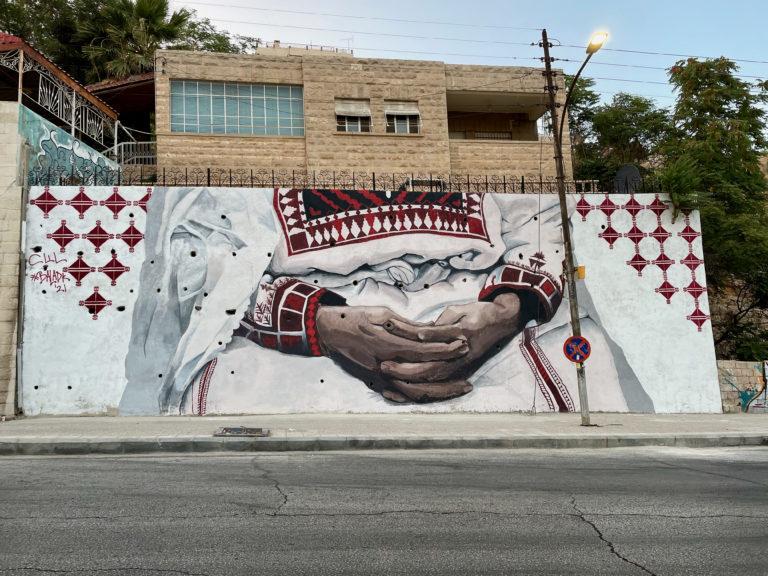The Challenges of Palestinian Solidarity in Amman’s Street Art Scene
Excerpt:
One of the final murals produced in response to the spring and summer 2021 protests brings the interconnected power relations between street artists, the state and institutional art patrons further into focus. In August, Dalal Mitwally, an early-career artist, created the mural for Baladk (a bespoke transliteration of “Your Country” in Arabic), an annual street art festival sponsored by GAM and various non-governmental organizations and international embassies. By this time, most artists had stopped creating Palestine solidarity art. Other artists I spoke with at the beginning of this period never got around to painting their planned solidarity murals because income-generating and career-boosting work took precedence. Located in Jabal al-Weibdeh, Mitwally’s mural is based on a photograph of Halimeh al-Dajani, a Palestinian woman from Jaffa who was displaced to al-Hussein refugee camp in Jordan in 1948. The work—produced in collaboration with Tiraz Centre, a museum and educational institution in Amman dedicated to the clothing of the Levant—depicts Halimeh’s torso wearing a Palestinian dress or thobe adorned with tatreez cross-stitching. According to Mitwally’s Instagram, the mural honors the stories passed down from older generations and, along with them, a sense of identity and “revolutionary resistance.”
Audiences widely celebrated Mitwallly’s mural as an act of rebellion, not always for its pro-Palestine message, but for containing aesthetic qualities that represent “our society” when much Amman street art consists of images like cartoon characters and graffiti-style lettering that many residents malign as “foreign.” The head of GAM’s cultural department, Shima Al Tal, stopped by the mural for a photo-op. The GAM official I mentioned earlier, who expressed anxieties about the PFLP dictating the city’s public aesthetics, said this mural is an exemplary representation of “our heritage” while eliding the work’s connection to Palestine and Palestinians. While Mitwally’s mural is not as direct as an Israeli flag on a trash can or a line from Samih al-Qasim’s resistance poetry, it—along with the artist’s commentary about the work—offers multiple avenues of reflection and discussion about the forced displacements of 1948 and 1967 and the experiences of Palestinian refugees in Jordan. This mural is one example of how artists’ efforts to work within the limits of the system while building careers comes with the risk of the state and other prominent institutions co-opting their aspirations and practices. The more they work within the limits of expression enforced by the government, the easier it is for art to serve as tools for smoothing out the contradictions between the state’s public image as forward-thinking and actual state restrictions on political participation in practice.
Source:
https://merip.org/2022/03/the-challenges-of-palestinian-solidarity-in-am...

